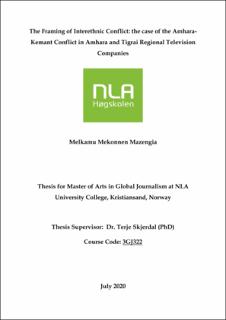| dc.description.abstract | Ethiopia is a multi-ethnic country, severely affected by violent interethnic conflicts that have disturbed people‟s lives and the country‟s socio-political conditions for the last quarter of a century. This study is intended to evaluate the framing of conflict news coverage by two regionally operated media companies, the Amhara Television (ATV) as a local and Tigrai Television (TTV) as an outsider, in relation to the Amhara and Kemant conflict. The dominant framing typologies, the attributed sources, and the role of the two television companies in reference to the peace/war journalism frame are assessed. Both quantitative and qualitative techniques are employed. In the quantitative aspect, the news content is examined to answer frame and source related questions. The study found that ATV primarily applies the attribution of responsibility frame and the conflict frame in second level. Morality, human interest, and economic frames are the rarely used by ATV. TTV on its part was found to focus on conflict frame first and attribution of responsibility frame second. Both stations highlight officials and common people as their source of news over other sources. On ATV, half of the stories used government officials as a source, while common people were the second most attributed source. Opinion leaders, opposition parties, victims, and experts were rarely attributed. TTV, on its side, used common people even more, with government officials ranked second, making up one-fourth of the sources. In relation to war/peace journalism, ATV emphasizes the peace journalism frame, while the majority of TTV‟s stories was inclined to war journalism. However, the qualitative data give divergent results in the case of TTV news. In relation to the qualitative data, five respondents were interviewed with semi-structured questions; three from ATV and two from TTV. The study reveals that both ATV and TTV were aspiring to resolve the conflict and identify solutions for the observed problems. However, because of the political antagonism and ethnic extremism expressed in the two regional governments, and the unwillingness of the sources to be attributed, professionalism and news framing are challenged. Apart from solving the conflict, the two media companies covered the conflict in a way that is meant to benefit their respective ethnic groups. The two media news reports prove the presence of ideological and proxy war in media messages. While TTV struggles for the implementation of constitutional rights, which shows a support for the Kemant, ATV pretends to reverse anti-Amhara narratives. | en_US |
